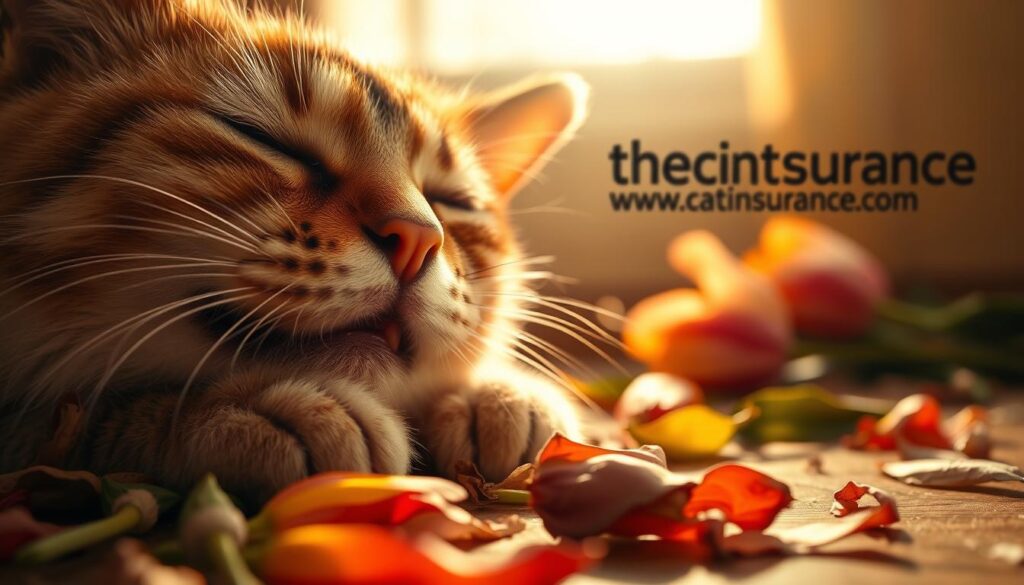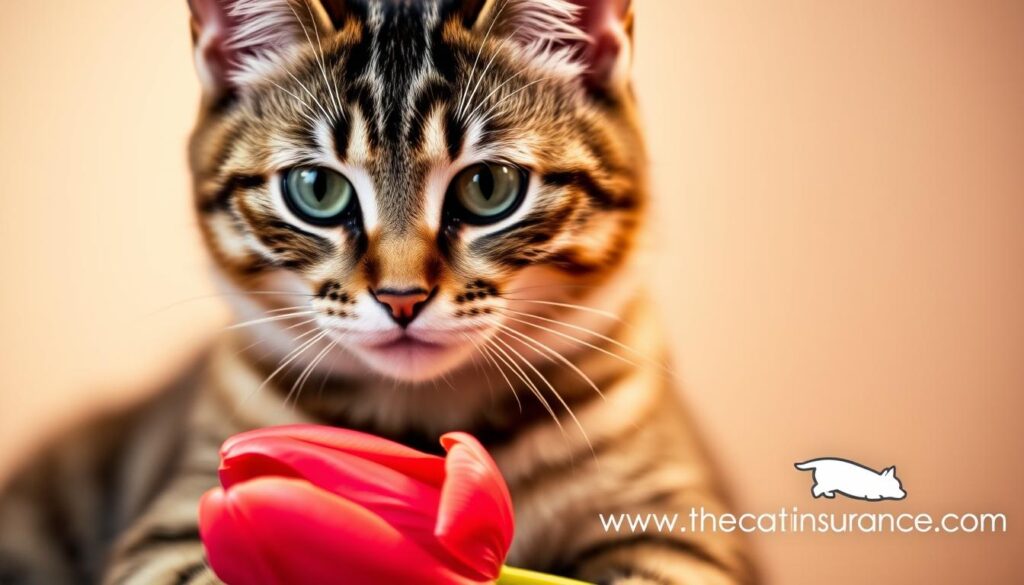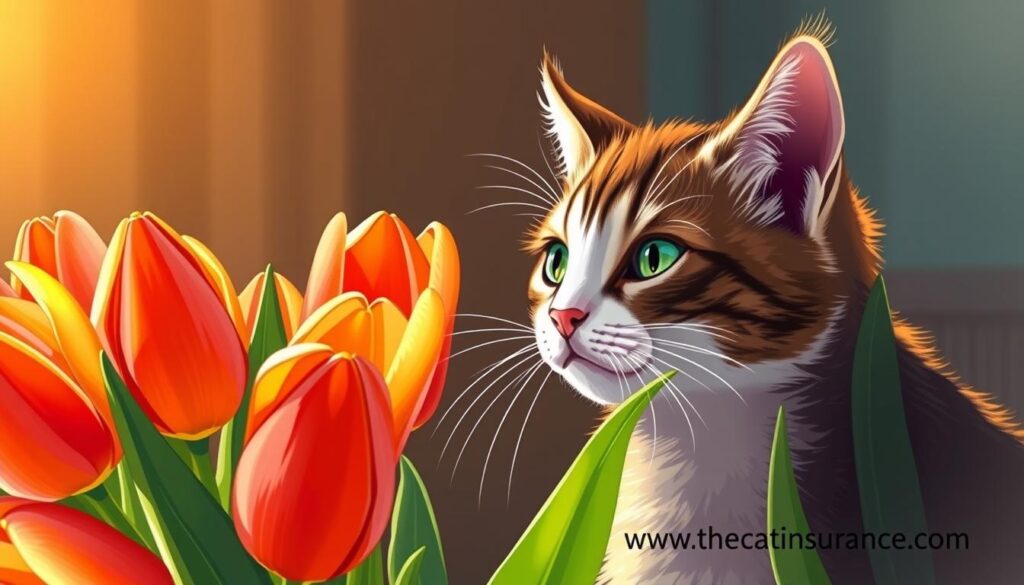Are Tulips Toxic To Cats : As a cat owner, you love those moments when your cat curls up next to you. They purr happily. But have you thought about dangers in your garden or vase? Tulips, with their bright colors and elegant petals, are loved by many. Yet, their beauty hides a danger.
Tulips belong to the Lily family and have toxic compounds. These can harm your cat if they eat them. It’s important to know the risks and keep your pet safe. Having the right insurance can also give you peace of mind. For more on cat insurance, visit www.thecatinsurance.com.
Key Takeaways
- Understand the risks associated with tulip toxicity in cats.
- Learn how to identify the symptoms of tulip poisoning.
- Discover ways to protect your cat from tulip toxicity.
- Explore the importance of cat insurance in covering veterinary expenses.
- Find resources for cat owners to stay informed about pet safety.
The Beauty and Potential Danger of Tulips
Tulips are stunning, but they can also be dangerous. They are loved for their bright colors and elegant look. But, they can be a problem for pet owners.
Why Tulips Are Popular in American Homes
In America, tulips are a hit with gardeners and homeowners. Their beauty and variety of colors are big reasons why. Tulips are also easy to care for, making them perfect for all gardeners. They brighten up any space, which is why many people have them.
The Hidden Risks for Pet Owners
While tulips are beautiful and easy to care for, they can harm cats. Tulip ingestion can be toxic to cats, leading to symptoms from mild to severe. Cat owners need to know this risk when deciding to have tulips at home.
| Risks | Symptoms | Precautions |
|---|---|---|
| Tulip ingestion | Vomiting, diarrhea, lethargy | Keep tulips out of reach |
| Toxic components | Severe cases: respiratory problems | Monitor cat behavior around tulips |
Are Tulips Toxic to Cats?
Tulips make your home look beautiful, but they can harm cats. If you have cats, it’s important to know the dangers of tulips.
Scientific Evidence of Tulip Toxicity
Research shows tulips have toxic parts that can hurt cats. Some parts are more dangerous than others. Tulips are toxic to cats and can cause many symptoms.
Studies have found the exact toxins in tulips. This helps us understand why they’re bad for cats.
Toxic Components in Tulips
Tulips have tulipalin A and B, which are the main toxins. Knowing about these compounds is key to understanding the risks.
Tulipalin A and B: The Dangerous Compounds
Tulipalin A and B are allergens and toxins in tulips. They cause the bad reactions in cats when they eat them.
- Tulipalin A is very allergenic.
- Tulipalin B also makes tulips toxic, but in a different way.
Concentration Levels in Different Tulip Varieties
The amount of tulipalin A and B varies in tulips. The bulb has the most of these toxins, making it the biggest danger for cats.
Also, different tulip types might be more or less toxic. But it’s safest to think all tulips are risky for your cats.
Understanding Tulip Toxicity Levels
It’s important for cat owners to know how toxic tulips are. Tulips have harmful compounds that can hurt cats if they eat them. Knowing which parts of the plant are most dangerous is key.
Which Parts of the Tulip Are Most Dangerous
The tulip bulb is the most toxic part. It has the most harmful compounds. While the flowers and leaves are toxic too, the bulb is the biggest risk for cats. If your cat eats any part of the tulip, get veterinary care for tulip toxicity in cats right away.
- The bulb is the most toxic part of the tulip.
- The flowers and leaves are also toxic but less so than the bulb.
- Ingestion of any part of the tulip can cause toxicity in cats.
Comparing Tulips to Other Toxic Plants
Not just tulips are toxic to cats. Plants like daffodils and lilies are also harmful. Knowing how different plants compare can help make your home safer for pets. For example, tulips are toxic, but lilies are much more dangerous.
- Lilies are highly toxic to cats and can cause severe kidney damage.
- Daffodils contain toxic compounds that can cause vomiting and other symptoms.
- Tulips, while toxic, are generally less dangerous than lilies but still require caution.
By understanding tulip toxicity in cats and taking steps to prevent it, you can keep your cats safe and healthy.
Signs and Symptoms of Tulip Poisoning in Cats
It’s important to know the signs of tulip poisoning in cats. Tulips are pretty but can be harmful if cats eat them. They have toxic compounds that can hurt your pet.
Early Warning Signs
The first signs of tulip poisoning in cats are subtle but key to spot early. Look for vomiting, drooling, and lethargy. Your cat might also eat less and seem depressed.
Severe Symptoms Requiring Immediate Attention
Big problems can happen if your cat eats a lot of tulips. They might have convulsions, tremors, or even coma. These are serious signs that need vet help right away.
Timeline of Symptom Progression
Knowing when symptoms show up can help you act fast. How quickly they appear depends on how much your cat ate and their sensitivity.
First 2 Hours After Ingestion
In the first couple of hours, you might see vomiting and drooling. Keep a close eye on your cat during this time.
24-48 Hours After Exposure
Severe cases can get worse, leading to convulsions and breathing problems in 24 to 48 hours. If you see these signs, get vet help fast.
| Symptom | Timeline | Severity |
|---|---|---|
| Vomiting, Drooling | First 2 hours | Mild to Moderate |
| Convulsions, Tremors | 24-48 hours | Severe |
| Coma | 24-48 hours | Critical |
What Happens When a Cat Ingests Tulips
When a cat eats tulips, it can lead to health problems. Tulips have harmful compounds like allergenic lactones and tulipalin. Knowing how these affect cats is key for quick care.
The Physiological Impact on Feline Systems
Eating tulip parts, especially bulbs, can upset a cat’s stomach. Symptoms include drooling, vomiting, and breathing issues. Tulips can harm a cat’s stomach, heart, and lungs.
Gastrointestinal symptoms like nausea and diarrhea are common. Cats might also have cardiovascular issues like a fast heart rate.
| System Affected | Common Symptoms | Severity Level |
|---|---|---|
| Gastrointestinal | Vomiting, Diarrhea, Drooling | Mild to Moderate |
| Cardiovascular | Increased Heart Rate, Blood Pressure Changes | Moderate to Severe |
| Respiratory | Difficulty Breathing, Rapid Breathing | Severe |
How Quickly Toxicity Takes Effect
Symptoms can show up a few hours after eating tulips. The toxicity can worsen fast. Quick vet care is vital.
Keep an eye on your cat if you think they ate tulips. Seek vet help right away if they show signs. Early action can help a lot.
Emergency Response: What to Do If Your Cat Eats Tulips
If you think your cat has eaten tulips, act fast. Tulips can be toxic to cats and cause serious health issues. It’s important to know what to do right away.

Immediate First Aid Steps
Act quickly if you see your cat eating tulips or if you find tulip parts on them. First, remove any remaining tulip parts from your cat’s mouth or fur. This can help prevent more harm.
Next, stay calm and watch your cat for any signs of illness. It’s important to keep an eye on them. But, don’t try to make them vomit or give them any treatment without talking to a vet first.
When to Contact Your Veterinarian
Calling your vet is key when dealing with tulip toxicity. Reach out to your vet right away if you think your cat ate tulips, even if they seem okay. The vet can give advice based on how much was eaten and your cat’s health.
Information to Provide to Your Vet
When you call your vet, have this info ready:
- The amount of tulip material you believe your cat ingested
- The time frame in which the ingestion occurred
- Any symptoms your cat is exhibiting
- Your cat’s age, weight, and any pre-existing health conditions
| Information Required | Importance |
|---|---|
| Amount Ingested | Helps assess toxicity level |
| Time Frame | Critical for determining the urgency of the situation |
| Symptoms | Guides immediate care and treatment |
Preparing for an Emergency Visit
If your vet says you need to come in, be ready to go. Take any important info, like the tulip plant or packaging. This helps the vet figure out the type of tulip and how toxic it is.
For more tips on vet visits and pet emergencies, check out www.thecatinsurance.com. They have useful resources and advice.
Veterinary Treatment for Tulip Poisoning
If your cat eats tulips, you need to get them to the vet fast. Tulip poisoning can cause serious health problems in cats. Quick action is important to avoid worse issues.
Diagnostic Procedures
At the vet, they will check your cat and ask about their symptoms and tulip exposure. They might do blood work and urinalysis to see how bad the poisoning is.
The vet will also want to know how much and what part of the tulip your cat ate. This helps figure out how bad the poisoning is.
Common Treatment Protocols
Here’s what usually happens to treat tulip poisoning in cats:
- Inducing vomiting to get rid of the poison, if it was eaten recently.
- Gastric lavage to clean the stomach.
- Supportive care, like IV fluids, to help with symptoms and prevent dehydration.
- Monitoring your cat’s health closely for any bad signs.
In very bad cases, more treatments might be needed, like medicine for specific symptoms.
Recovery Expectations and Follow-up Care
How well a cat does after eating tulips depends on how much they ate and how fast they got help. With quick and right vet care, many cats get better. It’s very important to follow up to make sure your cat is okay and to fix any health problems.
Your vet will tell you what to do next and how to keep an eye on your cat’s health.
Preventing Tulip Poisoning in Your Home
Keeping your cat safe from tulip poisoning is very important. Tulips are beautiful but can be harmful to cats if they eat them. You can enjoy your tulips and keep your cat safe by following a few simple steps.
Safe Flower Alternatives for Cat Owners
If you love flowers and have a cat, look for safe options. Sunflowers, zinnias, and snapdragons are pretty and safe for cats. This way, you can have flowers without worrying about your cat’s health.
Creating Cat-Safe Spaces
Creating safe areas for your cat is a good idea. Make sure your cat has places to relax and play without getting near the tulips. You can do this by setting up cat-friendly rooms or areas where plants are not allowed.
Training Your Cat to Avoid Plants
Teaching your cat to stay away from plants is a long-term solution. There are many ways to keep cats from eating plants.
Deterrent Methods That Work
- Spraying plants with citrus-based sprays
- Placing double-sided tape around plants
- Using ultrasonic repellent devices
Environmental Enrichment Strategies
Keeping your cat busy can also help. Give them interactive toys and cat trees to keep them interested in other things, not the tulips.
By using these strategies, you can greatly lower the risk of tulip poisoning in your home. A little planning and creativity can make a big difference in keeping your cat safe and healthy.
Cat Insurance Coverage for Plant Poisoning
Tulip poisoning in cats is a real concern. The right insurance can save your cat’s life. As a cat owner, you want to keep your pets safe and manage unexpected vet costs.
Cat insurance is key for covering veterinary care for tulip toxicity in cats. If your cat eats tulips, it can lead to expensive emergency treatments.
How Insurance Can Help With Emergency Veterinary Costs
Insurance can ease the financial stress of emergency vet care. For tulip poisoning, your cat might need treatments like inducing vomiting or activated charcoal. They might also need intravenous fluids.
With insurance, you can rest easy knowing you’re covered. It means you can focus on your cat’s care without worrying about vet bills.
What to Look for in a Cat Insurance Policy
Not all cat insurance is the same. Look for a policy that covers poisoning, including tulip poisoning in cats. Make sure it includes diagnostic tests, treatments, and hospital stays.
It’s also key to understand the policy’s details. Check for deductibles, co-pays, and exclusions. Some policies might have special rules for poisoning or toxic substances.
Coverage Options from TheCatInsurance.com
TheCatInsurance.com offers great coverage for poisoning incidents. Their policies aim to protect you from unexpected vet costs. This lets you focus on your cat’s recovery.
Filing Claims for Poisoning Incidents
If your cat is poisoned by tulips, filing a claim is easy. You’ll need to give your vet’s documentation. This includes the diagnosis, treatment, and costs.
| Insurance Feature | Description | Benefit |
|---|---|---|
| Comprehensive Coverage | Covers diagnostic tests, treatments, and hospitalization for poisoning | Financial protection against high veterinary bills |
| Easy Claims Process | Straightforward process for filing claims with required documentation | Reduces stress during emergencies |
| Customizable Policies | Options to tailor coverage to your cat’s needs | Ensures you’re not over-insuring or under-insuring your pet |

Real-Life Cases: Cats and Tulip Encounters
Many cat owners have seen the dangers of tulips for their pets. They learn this the hard way when their cat eats tulips. It’s crucial to get vet help fast.
Survivor Stories and Lessons Learned
Some cat owners have shared their scary moments. One cat, Whiskers, ate a lot of tulip petals. Quick vet care saved Whiskers. This taught the owner to keep tulips away from cats.
These stories show how important it is to watch your cat closely. If a cat eats tulips, it can get very sick. Symptoms include vomiting, diarrhea, and breathing problems.
Veterinarian Perspectives on Tulip Toxicity
Vets say tulip poisoning is a big deal and needs quick action. Dr. Jane Smith, a vet with 10 years of experience, says, “Tulip eating is a big problem for cats. Cat owners need to know the risks and protect their pets.”
| Symptoms | Severity | Action Required |
|---|---|---|
| Vomiting, Diarrhea | Mild to Moderate | Monitor closely, consult a vet |
| Respiratory Problems, Lethargy | Severe | Immediate veterinary care |
Conclusion: Keeping Your Feline Friend Safe Around Flowers
As a cat owner, it’s important to know about the dangers of tulips and other toxic flowers. These dangers can harm your pet. Knowing the risks helps prevent accidents.
Preventive steps like choosing safe flowers and keeping toxic ones away are key. If your cat eats tulips, act fast and get vet help.
Getting cat insurance can also give you peace of mind. It helps cover vet costs. Check out www.thecatinsurance.com for more info.
By staying informed and taking action, you can make a safe home for your cat. This way, your cat can enjoy a happy life without tulip dangers.

